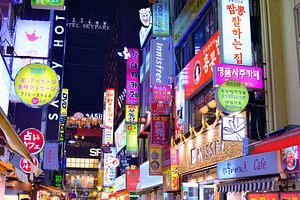Although South Korea is stepping up efforts to become an innovative and entrepreneurial economy, entrepreneurial possibilities remain slim for the majority of the population.
President Park Geun-hye began her term in 2013 with plans to create a “creative economy, » driven by a vibrant startup culture in the tech industry. Since then, the Park administration has launched a number of initiatives to promote investment in emerging startups, including tax incentives for angel investors and financial insurance for those planning to open new businesses.
Indeed, the recent successful growth of several South Korean startups have attracted attention from international venture capitalists. Some business experts have pointed at South Koreans’ characteristic perseverance and discipline as foundations for a flourishing startup ecosystem. In 2014 alone, some 840,000 companies sprang up, in a country with a population of 50 million. This high number of enterprises relative to GDP suggests that opening a business is a poplar economic activity for many South Koreans.
Yet a closer look at the indicators paints a different picture of entrepreneurship in South Korea. First, the majority of new businesses springing up are far from innovative startups. South Korea’s economy is heavily reliant on necessity-driven entrepreneurship, or opening a business merely to find employment. Typically, countries have higher ratios of opportunity-driven entrepreneurship as their economies develop, but the weight of opportunity-driven entrepreneurship in South Korea remains weaker than in other OECD countries. In a 2014 survey, more than 80 percent of small and medium enterprise (SME) owners in South Korea said that they opened their businesses as a means to find work or to support themselves.
Naturally, many of new enterprises are concentrated in low-productivity sectors such as retail and food and beverage. From 2010 to 2014, the number of restaurants, bars and other drink stores increased 12 percent from 581,000 to 651,000, vastly outpacing the population growth of around 2 percent. The average age of business owners is also increasing, since opening a business has become an option for retirees more than it has a career option for young people.
Further evidence of necessity-driven entrepreneurship is a rapid expansion of franchise brands. The number of franchise stores in South Korea has risen rapidly since 2009, when the Baby Boom generation (born between 1955 and 1963) began to retire in the aftermath of the 2008 economic crisis. Opening a franchise outlet is a relatively easy option for many low-skilled workers who have departed their previous jobs, since each store operates with a degree of financial and branding support from franchise headquarters. This explosion of franchise stores in low-productivity sectors pushes up the number of “enterprises” counted in national surveys, but does little in terms of value generation.
The outcome of these trends is an excess competition. Any visitor to South Korea would have seen multiple stores serving the exact same purpose facing each other in a small geographical area – for example, Seoul has eight fried chicken restaurants for every 0.62 mile. In more extreme cases, stores of the same franchise brands compete against each other. In the booming commercial district in Bundang, Sungnam City, three makeup stores of the same retail brand used to be evenly spaced every 0.15 mile, until the oldest went out of business.
The biggest victims in this trend are of course enterprise owners. Youngmi Kim, who runs a franchise convenience store in Gwangju, explained that convenience stores flooded the area after news emerged that nearby neighborhoods would soon be developed. According to Kim, the addition of one competitor typically results in a monthly loss of 3 million won ($2,500).
Given this trend, it is not surprising that the country has a strikingly low survival rate of individual enterprises. On average, only 60 percent of new enterprises are still in business after the first year. The number falls to less than 30 percent after five years.
A research fellow at Hyundai Research Institute Ho-jung Cho points out that this kind of necessity-driven, short-lived business ecosystem contributes little to the health of the economy. “Necessity-driven enterprises have very low survival rates, which lead to the owners’ increased economic hardships, limited contribution to employment and weak competitiveness of businesses,” Cho said.
Indeed, there is no evidence that the flood of new companies has created jobs for young people who have just entered the job market. The employment to population ratio among young people is currently around 40 percent, which is around 4 percentage points lower than it used to be ten years ago. Statistics show that the majority of new businesses, if they hire at all, recruit at most one employee.
It seems that the current South Korean government has focused on startups partly to address the unemployment problem. But aside from the effectiveness of the policy, for the rest of the population – especially those older and less-educated – running a tech startup is not an easily imaginable future. In fact, for many, opening business themselves may just not be the solution for their economic hardships.
Encouraging a strong tech startup ecosystem is definitely one way to leap forward to the next level of economic development. But the challenge for South Korea also lies in creating an environment in which people don’t have to become an “entrepreneur” simply to find work.
Eunsun Cho is a student at Georgetown University majoring in international politics.

































